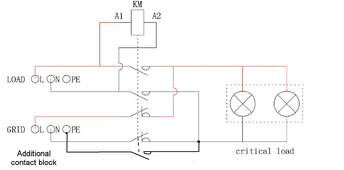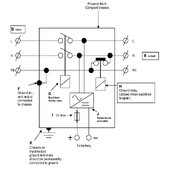Joseph_Martin
New Member
- Joined
- Apr 19, 2022
- Messages
- 7
Hi,
I've just had a periodic inspection of our electrical installation, as it's ten years since our home was first built (I'm in the UK where we're supposed to get inspections done every ten years). Unfortunately the electrician has failed our installation because of a serious safety defect with the Sofar ME3000SP. We have six Pylontech batteries connected to the Sofar ME3000SP inverter/charger and the system has worked very well for about three years now (and was still working well until the electrician disconnected it as being unsafe). I've tried to contact the installer we used but it seems they are no longer in business. I also tried to contact Sofar in China who were simply dismissive and extremely unhelpful. I've not been able to find any UK agent for Sofar, only re-sellers.
The system was installed so that in grid mode it charges the batteries from excess power from our solar system, or charges them over night during the off-peak cheap rate period. The batteries then run most of the power for the house during the day, when grid electricity is more expensive. Up until the time it was disconnected it has always worked very well and massively reduced our bills. In addition to this, the installer also wired the emergency power supply output of the unit to a changeover contactor and a small consumer unit that runs the lighting circuit plus a single socket circuit that runs our internet stuff plus the TV. This has also always worked very well, as we live in an area that gets a few power cuts each winter and having power back on to the lights etc a couple of seconds after the grid goes down is very useful.
Talking to the electrician he has declared it unsafe to use because of the emergency power circuit. On the report he has stated that, when he tested it he found that there was no neutral to protective earth bond when the system was running in EPS mode. He's also noted that he measured an unsafe voltage between neutral and protective earth and this is given as the reason for disconnecting the system as being unsafe to use. His report does also mention that the neutral to protective earth fault is not present when the system is running normally (i.e. when there isn't a power cut). I've done lots of research over the past few days and found a great deal of useful information about neutral to earth bonding relays, along with some heated debates about whether or not these are needed, safe, etc.
Our electrical installation has a TT earthing system, with an earth rod by the meter cabinet and an RCD and fuse unit on the cable that feeds the house (the house is about 10m away from the meter cabinet and fed via a length of hefty armoured cable). I believe that the Sofar ME3000SP is like several other Chinese inverter/chargers in that it does not have an internal neutral/earth relay. I tried to get Sofar to answer the question as to whether one could be wired externally (as suggested for some other inverters with this same issue) but they just told me that the ME3000SP is an old product and they do not support it now. I've talked with the electrician and he has said that it would be easy to add an additional contact block to the existing changeover contactor, wired so that the EPS neutral was switched to earth when the contactor energised. This sounds great, as he's said it's a very quick and easy job and the part needed isn't that expensive. However, he doesn't want to risk doing it unless he knows for sure it isn't going to cause damage.
So, my question is, does anyone know for sure if it is safe to just add another switch to the existing changeover contactor that links the EPS neutral to earth when in off-grid mode, please?
I've just had a periodic inspection of our electrical installation, as it's ten years since our home was first built (I'm in the UK where we're supposed to get inspections done every ten years). Unfortunately the electrician has failed our installation because of a serious safety defect with the Sofar ME3000SP. We have six Pylontech batteries connected to the Sofar ME3000SP inverter/charger and the system has worked very well for about three years now (and was still working well until the electrician disconnected it as being unsafe). I've tried to contact the installer we used but it seems they are no longer in business. I also tried to contact Sofar in China who were simply dismissive and extremely unhelpful. I've not been able to find any UK agent for Sofar, only re-sellers.
The system was installed so that in grid mode it charges the batteries from excess power from our solar system, or charges them over night during the off-peak cheap rate period. The batteries then run most of the power for the house during the day, when grid electricity is more expensive. Up until the time it was disconnected it has always worked very well and massively reduced our bills. In addition to this, the installer also wired the emergency power supply output of the unit to a changeover contactor and a small consumer unit that runs the lighting circuit plus a single socket circuit that runs our internet stuff plus the TV. This has also always worked very well, as we live in an area that gets a few power cuts each winter and having power back on to the lights etc a couple of seconds after the grid goes down is very useful.
Talking to the electrician he has declared it unsafe to use because of the emergency power circuit. On the report he has stated that, when he tested it he found that there was no neutral to protective earth bond when the system was running in EPS mode. He's also noted that he measured an unsafe voltage between neutral and protective earth and this is given as the reason for disconnecting the system as being unsafe to use. His report does also mention that the neutral to protective earth fault is not present when the system is running normally (i.e. when there isn't a power cut). I've done lots of research over the past few days and found a great deal of useful information about neutral to earth bonding relays, along with some heated debates about whether or not these are needed, safe, etc.
Our electrical installation has a TT earthing system, with an earth rod by the meter cabinet and an RCD and fuse unit on the cable that feeds the house (the house is about 10m away from the meter cabinet and fed via a length of hefty armoured cable). I believe that the Sofar ME3000SP is like several other Chinese inverter/chargers in that it does not have an internal neutral/earth relay. I tried to get Sofar to answer the question as to whether one could be wired externally (as suggested for some other inverters with this same issue) but they just told me that the ME3000SP is an old product and they do not support it now. I've talked with the electrician and he has said that it would be easy to add an additional contact block to the existing changeover contactor, wired so that the EPS neutral was switched to earth when the contactor energised. This sounds great, as he's said it's a very quick and easy job and the part needed isn't that expensive. However, he doesn't want to risk doing it unless he knows for sure it isn't going to cause damage.
So, my question is, does anyone know for sure if it is safe to just add another switch to the existing changeover contactor that links the EPS neutral to earth when in off-grid mode, please?






